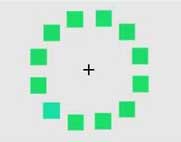Language changes the way you look at life
Our sense of color depends on whether you look at them from the left or right. Researchers say this demonstrates that language can change the way we see the world.

The left hemisphere "language love" can recognize different colors faster when distinguishing different shades of the same color.
The idea that language can change awareness is not new. In the 1930s, American linguist Benjamin Lee Whorf proposed a controversial hypothesis that the structure of language influenced the way of thinking of people. Subsequent studies have indirectly suggested that this may be true in some cases (for example, a tribe that does not know how to count because there is no name for the serial number). But whether language affects our perception of the world is still an open question.
Richard Ivry of the University of Berkeley, Calif. And colleagues hypothesized that the same visual input but caused different effects on the left and right hemispheres may be meaningful in this case. The language is primarily handled by the left hemisphere, also the hemisphere processing signals from the left side of the retina in both of our eyes.
Because the light from the object to our right is mostly illuminated on the left side of the retina, the researchers hypothesize that the color of the object on the right will be affected by the stronger language. In contrast, the object on the left activates the right hemisphere, so the effect of language will be minimal.
 To test this idea, they showed a group of people a picture of green squares arranged in a circle. The team then measured how long it took for these people to see a single square of a different color, on the right or left.
To test this idea, they showed a group of people a picture of green squares arranged in a circle. The team then measured how long it took for these people to see a single square of a different color, on the right or left.
The other eccentric square is dark green or the rest of the squares, or blue. If it is on the left, volunteers detect both types (dark green and blue) at the same time. But if on the right, the volunteer chose the green box for longer than the blue.
The researchers explained that this is because the blue color has a distinctly different name, so the left hemisphere (with the "language-loving" attribute) can perceive the difference in color more quickly than with The square is dark green.
Ivry and colleagues continue to test the hypothesis by asking participants to memorize a series of words, while repeating the above visual test. As a result, with the left brain center becoming "busy", it has little chance of affecting visual perception, and so as expected, participants choose a colored square. Blue or green on the right of the picture with the same time.
" This proves the effect of the first experiment actually due to language ," commented Michael Corballis from Auckland University, New Zealand. His experiment also produced similar results.
Ivry's team is now investigating whether a similar effect is observed in familiar objects, such as cats or cars, but not just colors, or not. Previous studies have shown that we actually see everyday objects under different states, depending on their location and names.
- Oysters with language like?
- The best way to help children develop language skills
- Programming language history
- Restoring ancient language
- The 'new world' scenario if humans speak a common language
- Marvel at the world's least worded language with only 123 words
- Gloves turn speech language into words
- What language did the ancients use?
- Race against time to preserve language
- Human language derives from the song of apes and birds
- Addiction messaging is not good for language skills
- How old can you still be in a foreign language?
 Green tea cleans teeth better than mouthwash?
Green tea cleans teeth better than mouthwash? Death kiss: This is why you should not let anyone kiss your baby's lips
Death kiss: This is why you should not let anyone kiss your baby's lips What is salmonellosis?
What is salmonellosis? Caution should be exercised when using aloe vera through eating and drinking
Caution should be exercised when using aloe vera through eating and drinking